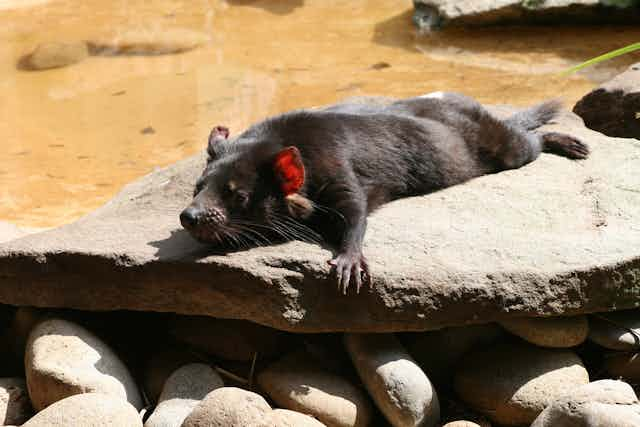In almost all parts of the world our environment is under siege and we are losing the battle to save many species from extinction. The most common threats behind this unfolding catastrophe are habitat loss and modification, invasive species, and climate change. What can we do?
Usually we focus on treating the symptoms — planting trees or shooting pest animals — but these treatments often fail. Perhaps we need radical new solutions for fixing broken ecosystems.
One such solution could be introducing (or reintroducing) species to ecosystems. There is now a serious and broad-based proposal to release Tasmanian Devils into the wild at Wilsons Promontory in Victoria, saving devils from extinction in Tasmania, and restoring damaged ecosystems on the mainland.
What is rewilding?
We can look at the Tasmanian Devil proposal in terms of an ecological concept known as rewilding. In essence, rewilding seeks to restore ecological function to habitats by introducing or reintroducing species that could perform vital roles.
Perhaps the best example comes from Yellowstone National Park in the US, where wolves were returned after a 70-year absence. Wolves are crucial to Yellowstone’s ecosystems. Without them herbivores like deer and moose flourish, and prevent trees from producing saplings (see video below).
In Australia, the Tasmanian Devil is an ideal candidate for reintroduction to the mainland.
Saving devils
Tasmanian Devils used to inhabit mainland Australia. When exactly they went extinct on the mainland is uncertain, with dates ranging from 5,000 to as recent as 500 years ago. But in 1881 Frederick McCoy, the first director of the National Museum, noted that Tasmanian Devils (or perhaps that should be “mainland” devils) are very common in the most recent cave deposits in Victoria. These fossils are identical to living devils in Tasmania.
Why they became extinct is more mysterious. Various theories have attributed blame to climate change, over-hunting by Aboriginal Australians, and dingoes.
But whatever the cause, current conditions at Wilson’s Promontory closely resemble those in Tasmania, and have likely remained unchanged for thousands of years, with no dingoes and plenty of prey. So we can be sure that the devils would fit in.
But why move them now?
One excellent reason is that there is a genuine risk that devils could become extinct in the wild by 2025, as a result of devil facial tumour disease (DFTD). A mainland population would act as a large, wild insurance population, outside of Tasmania where DFTD is present.
How would the mainland benefit?
So we know Tasmanian Devils have been on the mainland before, and that moving them might help save the species from extinction. But what could devils offer the mainland?
One of the biggest benefits devils could offer is in the control of the red foxes, feral cats and overabundant herbivores (such as wombats, rabbits and wallabies). Evidence for this comes from Tasmania. Following the decline of devils due to DFTD, species such as the feral cat have been increasing. This in turn is associated with a halving in population size of a smaller, native predator, the Eastern Quoll (once present, but now extinct in Victoria).
Some have also suggested that the reason foxes have only recently established themselves in Tasmania is not solely due to humans introducing them, but because devils declined around the same time. Prior to DFTD, devils may have been acting as a first line of defence against foxes by killing their cubs.
Currently we spend a lot of money managing foxes on mainland Australia through baiting programs. But are we going to do this forever? Devils may provide a 24-7 predator control service, free of charge.
Focusing on foxes also ignores the fact that there is no effective control of probably Australia’s most damaging feral animal, cats. As noted above, devils are capable of limiting cats too.
Another issue at Wilson’s promontory is an over-abundance of herbivores including wombats, swamp wallabies, rabbits, kangaroos and hog deer. All of these increased rapidly following the removal of dingoes in the 1940s.
In high numbers these herbivores can radically alter habitats, making them unsuitable for other species. We can shoot herbivores to keep them down, or we could introduce a natural predator such as Tasmanian Devils.
What’s next?
Parks Victoria and an ambitious multi-institutional research hub, the Wildlife Biodiversity Co-operative Research Centre are behind the new proposal to move devils to Wilson’s Promontory. Planning is underway for a comprehensive proposal to the Victorian and Tasmanian governments, and thorough consultation with the public.
With this in mind I urge our leaders to be bold and act now. There are always risks with moving species, but not taking calculated risks to conserve our wildlife is perhaps even worse. A devil reintroduction should be viewed as a positive and strategic national decision, and one for which future generations will thank us.
It is not often we can achieve win-wins in conservation, but helping prevent the extinction of the Tasmanian devil by re-establishing a mainland population, and restoring desperately needed ecosystem function to habitats, may just be the best conservation win-win waiting to happen.


